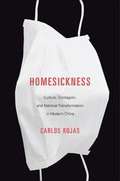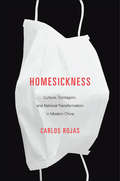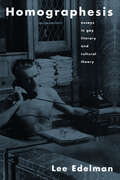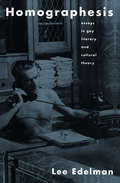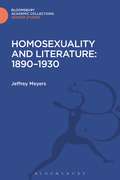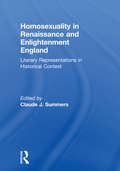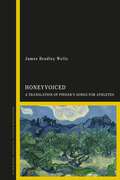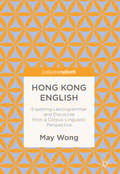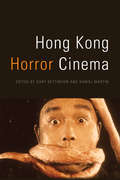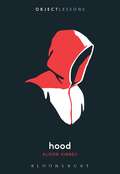- Table View
- List View
Homes and Homecomings: Gendered Histories of Domesticity and Return (Gender and History Special Issues #5)
by K. H. Adler Carrie HamiltonIn Homes and Homecomings an international group of scholars provide inspiring new historical perspectives on the politics of homes and homecomings. Using innovative methodological and theoretical approaches, the book examines case studies from Africa, Asia, the Americas and Europe. Provides inspiring new historical perspectives on the politics of homes and homecomings Takes an historical approach to a subject area that is surprisingly little historicised Features original research from a group of international scholars The book has an international approach that focuses on Africa, Asia, the Americas and East and West Europe Contains original illustrations of homes in a variety of historical contexts
Homesickness: Culture, Contagion, And National Transformation In Modern China
by Carlos RojasCarlos Rojas focuses on the trope of “homesickness” in China—discomfort caused not by a longing for home but by excessive proximity to it. This inverse homesickness marks a process of movement away from the home, conceived of as spaces associated with the nation, family, and individual body, and gives rise to the possibility of long-term health.
Homesickness: Culture, Contagion, And National Transformation In Modern China
by Carlos RojasCarlos Rojas focuses on the trope of “homesickness” in China—discomfort caused not by a longing for home but by excessive proximity to it. This inverse homesickness marks a process of movement away from the home, conceived of as spaces associated with the nation, family, and individual body, and gives rise to the possibility of long-term health.
Homi K. Bhabha (Transitions)
by Eleanor ByrneThis comprehensive introduction to the work of Homi K. Bhabha, a key figure in both postcolonial and post-structuralist theory, is accessible and engaging. It places Bhabha's work in context, considers his effect on contemporary criticism, offers readings of a range of texts to illustrate his theories, and features an interview with the theorist.
Homi K. Bhabha (Transitions)
by Eleanor ByrneThis comprehensive introduction to the work of Homi K. Bhabha, a key figure in both postcolonial and post-structuralist theory, is accessible and engaging. It places Bhabha's work in context, considers his effect on contemporary criticism, offers readings of a range of texts to illustrate his theories, and features an interview with the theorist.
Homicide in American Fiction, 1798–1860: A Study in Social Values
by David Brion DavisHomicide has many social and psychological implications that vary from culture to culture and which change as people accept new ideas concerning guilt, responsibility, and the causes of crime. A study of attitudes toward homicide is therefore a method of examining social values in a specific setting. Homicide in American Fiction, 1798–1860 is the first book to contrast psychological assumptions of imaginative writers with certain social and intellectual currents in an attempt to integrate social attitudes toward such diverse subjects as human evil, moral responsibility, criminal insanity, social causes of crime, dueling, lynching, the "unwritten law" of a husband's revenge, and capital punishment. In addition to works of literary distinction by Cooper, Hawthorne, Irving, and Poe, among others, Davis considers a large body of cheap popular fiction generally ignored in previous studies of the literature of this period. This is an engrossing study of fiction as a reflection of and a commentary on social problems and as an influence shaping general beliefs and opinions.
Homoeroticism and Chivalry: Discourses of Male Same-sex Desire in the 14th Century (The New Middle Ages)
by R. ZeikowitzZeikowitz explores both affirming and denigrating discourses of male same-sex desire in diverse fourteenth-century chivalric texts and describes the sociopolitical forces motivating those discourses. He attempts to dethrone traditional heteronormative views by drawing attention to culturally normative 'queer' desire. Zeikowitz articulates possible homoeroticized spectatorial interactions between male readers and imagined or actual model knights, dramatized accounts of same-sex unions, and mutually stimulating - or competing - forces of homosocial and heterosexual desire in chivalric texts, such as Charny's Book of Chivalry , Sir Gawain and the Green Knight , and Troilus and Criseyde . He also examines how intimate male bonds are rendered sodomitically-inflected, dangerous attachments in chronicle narratives of the reigns of Edward II and Richard II.
Homographesis: Essays in Gay Literary and Cultural Theory
by Lee EdelmanFirst published in 1994. Routledge is an imprint of Taylor & Francis, an informa company.
Homographesis: Essays in Gay Literary and Cultural Theory
by Lee EdelmanFirst published in 1994. Routledge is an imprint of Taylor & Francis, an informa company.
The Homosexual Revival of Renaissance Style, 1850–1930 (Palgrave Studies in Nineteenth-Century Writing and Culture)
by Y. IvoryWhy were so many late-nineteenth-century homosexuals passionate about the Italian Renaissance? This book answers that question by showing how the Victorian coupling of criminality with self-fashioning under the sign of the Renaissance provided queer intellectuals with an enduring model of ruthlessly permissive individualism.
Homosexuality and Literature: 1890-1930 (Gender Studies: Bloomsbury Academic Collections)
by Jeffrey MeyersAlthough artists are nowadays able to be openly gay and to address homosexuality explicitly in their work, this book argues that it was the harsh climate of 1890-1930 that produced the most outstanding explorations of homosexuality. To support his argument, Meyers illuminates the character and creative process of a range of authors of the period, including Wilde, Gide, Proust, E.M. Forster and T.E. Lawrence, and analyses the sexual problems that were sublimated and transcended in their art.
Homosexuality in Renaissance and Enlightenment England: Literary Representations in Historical Context
by Claude J SummersThis new book significantly contributes to an increased understanding of the gay and lesbian experience as it illuminates important works of literature and clarifies the status of same-sex desire in English literature from 1500--1760. Homosexual themes can be found throughout the literature of the English Renaissance and Enlightenment, but only rarely are they direct and unambiguous. The essays here are engaged in a vital and necessary process of re-historicizing and re-contextualizing literature. Utilizing a variety of critical methods and proceeding from several different theoretical and ideological presuppositions, these essays raise important questions about the methodology of gay studies, about the conception of same-sex desire, about the depiction of homoerotics, and about the relationship of sexuality and textuality, even as they shed new light on the homosexual import of a number of significant works of literature. Among the authors studied are Christopher Marlowe, William Shakespeare, John Donne, Lady Mary Wroth, Katherine Philips, Aphra Behn, John Cleland, and Thomas Gray. The collection attests both the current intellectual ferment in gay studies and the richness of English Renaissance and eighteenth-century literary representations of homosexuality.Homosexuality in Renaissance and Enlightenment England provides numerous insights into important works of literature and into significant theoretical issues implicit in the process of discerning and defining homosexuality in texts of earlier ages. All the contributors locate their texts in carefully delineated cultural and historical milieux. But they are not unduly constrained by either the tyranny of theory or the anxieties of anachronism. Rather than proceeding from hidebound or fashionably current ideologies, they sift the texts they study for the concrete evidence from which theories of sexuality might be constructed or modified. Hence, the collection will be valuable both for its practical criticism and for its theoretical contributions. It vividly illustrates the variety of gay studies in literature, especially as applied to works of earlier ages.
Homosexuality in Renaissance and Enlightenment England: Literary Representations in Historical Context
by Claude J SummersThis new book significantly contributes to an increased understanding of the gay and lesbian experience as it illuminates important works of literature and clarifies the status of same-sex desire in English literature from 1500--1760. Homosexual themes can be found throughout the literature of the English Renaissance and Enlightenment, but only rarely are they direct and unambiguous. The essays here are engaged in a vital and necessary process of re-historicizing and re-contextualizing literature. Utilizing a variety of critical methods and proceeding from several different theoretical and ideological presuppositions, these essays raise important questions about the methodology of gay studies, about the conception of same-sex desire, about the depiction of homoerotics, and about the relationship of sexuality and textuality, even as they shed new light on the homosexual import of a number of significant works of literature. Among the authors studied are Christopher Marlowe, William Shakespeare, John Donne, Lady Mary Wroth, Katherine Philips, Aphra Behn, John Cleland, and Thomas Gray. The collection attests both the current intellectual ferment in gay studies and the richness of English Renaissance and eighteenth-century literary representations of homosexuality.Homosexuality in Renaissance and Enlightenment England provides numerous insights into important works of literature and into significant theoretical issues implicit in the process of discerning and defining homosexuality in texts of earlier ages. All the contributors locate their texts in carefully delineated cultural and historical milieux. But they are not unduly constrained by either the tyranny of theory or the anxieties of anachronism. Rather than proceeding from hidebound or fashionably current ideologies, they sift the texts they study for the concrete evidence from which theories of sexuality might be constructed or modified. Hence, the collection will be valuable both for its practical criticism and for its theoretical contributions. It vividly illustrates the variety of gay studies in literature, especially as applied to works of earlier ages.
HoneyVoiced: A Translation of Pindar’s Songs for Athletes
by Dr James Bradley WellsThis new translation of Pindar's songs for victorious athletes marries philological rigour with poetic sensibility in order to represent the beauty of his language for a modern audience as closely as possible. Pindar's poetry is synonymous with difficulty for scholars and students of classical studies. His syntax stretches the limits of ancient Greek, while his allusions to mythology and other poetic texts assume an audience that knows more than we now possibly can, given the fragmentary nature of textual and material culture records for ancient Greece. It includes an authoritative introduction, both to the poet and his art and to ancient athletics, alongside brief orientations to the historical context and mythological content of each victory song. The inclusion of a glossary supplies additional mythological and historical information necessary to understanding Pindar's poetry for those coming to the works for the first time. His is the largest body of textual remains that exists for ancient Greece between Homer (conventionally dated to 750 BCE) and the Classical Period (480–323 BCE), and constitutes a rich resource for politics, history, religion, and social practices.
HoneyVoiced: A Translation of Pindar’s Songs for Athletes
by Dr James Bradley WellsThis new translation of Pindar's songs for victorious athletes marries philological rigour with poetic sensibility in order to represent the beauty of his language for a modern audience as closely as possible. Pindar's poetry is synonymous with difficulty for scholars and students of classical studies. His syntax stretches the limits of ancient Greek, while his allusions to mythology and other poetic texts assume an audience that knows more than we now possibly can, given the fragmentary nature of textual and material culture records for ancient Greece. It includes an authoritative introduction, both to the poet and his art and to ancient athletics, alongside brief orientations to the historical context and mythological content of each victory song. The inclusion of a glossary supplies additional mythological and historical information necessary to understanding Pindar's poetry for those coming to the works for the first time. His is the largest body of textual remains that exists for ancient Greece between Homer (conventionally dated to 750 BCE) and the Classical Period (480–323 BCE), and constitutes a rich resource for politics, history, religion, and social practices.
Hong Kong English: Exploring Lexicogrammar and Discourse from a Corpus-Linguistic Perspective
by May WongThis book systematically examines the linguistic features and socio-cultural issues of ‘Hong Kong English’. The author focuses on authentic data taken from the International Corpus of English (the Hong Kong component) and the Corpus of Global Web-based English to track the ways in which the English language in Hong Kong has been adapted by its users. She also analyses the emergence of new forms and structures in its grammar and discourse. While the phonetic and phonological aspects of this variety of English have been well documented, its grammatical peculiarities and social language use have been hitherto neglected. This book offers original insights into the grammatical and pragmatic/discoursal features of Hong Kong English and will therefore be of interest to those working in fields such as World Englishes and corpus linguistics.
Hong Kong Horror Cinema
by Gary Bettinson Daniel MartinExplores the problem of anthropomorphism: a major bone of contention in 8th to 14th-century Islamic theology
Hong Kong Horror Cinema
by Gary Bettinson Daniel MartinTraces and measures the material impact of Dickens' fiction in London's built environment
Honoré de Balzac (My Reading)
by Peter BrooksA book on the experience of reading Honoré de Balzac's La Comédie humaine which recounts the process of Peter Brooks's own discovery of Balzac. A personal account of coming to terms with Balzac: moving from more classical and restrained authors to the highly-coloured melodramatic novels of the Human Comedy, which give us the dynamics of a new and challenging world on the threshold of modernity. This volume shows readers how to read, and to love reading, Balzac, and how to engage with his vast work.
Honoré de Balzac (My Reading)
by Peter BrooksA book on the experience of reading Honoré de Balzac's La Comédie humaine which recounts the process of Peter Brooks's own discovery of Balzac. A personal account of coming to terms with Balzac: moving from more classical and restrained authors to the highly-coloured melodramatic novels of the Human Comedy, which give us the dynamics of a new and challenging world on the threshold of modernity. This volume shows readers how to read, and to love reading, Balzac, and how to engage with his vast work.
Hood (Object Lessons)
by Alison KinneyObject Lessons is a series of short, beautifully designed books about the hidden lives of ordinary things. We all wear hoods: the Grim Reaper, Red Riding Hood, torturers, executioners and the executed, athletes, laborers, anarchists, rappers, babies in onesies, and anyone who's ever grabbed a hoodie on a chilly day. Alison Kinney's Hood explores the material and symbolic vibrancy of this everyday garment and political semaphore, which often protects the powerful at the expense of the powerless-with deadly results. Kinney considers medieval clerics and the Klan, anti-hoodie campaigns and the Hooded Man of Abu Ghraib, the Inquisition and the murder of Trayvon Martin, uncovering both the hooded perpetrators of violence and the hooded victims in their sights.Object Lessons is published in partnership with an essay series in The Atlantic.
Hood (Object Lessons)
by Alison KinneyObject Lessons is a series of short, beautifully designed books about the hidden lives of ordinary things. We all wear hoods: the Grim Reaper, Red Riding Hood, torturers, executioners and the executed, athletes, laborers, anarchists, rappers, babies in onesies, and anyone who's ever grabbed a hoodie on a chilly day. Alison Kinney's Hood explores the material and symbolic vibrancy of this everyday garment and political semaphore, which often protects the powerful at the expense of the powerless-with deadly results. Kinney considers medieval clerics and the Klan, anti-hoodie campaigns and the Hooded Man of Abu Ghraib, the Inquisition and the murder of Trayvon Martin, uncovering both the hooded perpetrators of violence and the hooded victims in their sights.Object Lessons is published in partnership with an essay series in The Atlantic.
Hooked: Art and Attachment
by Rita FelskiHow does a novel entice or enlist us? How does a song surprise or seduce us? Why do we bristle when a friend belittles a book we love, or fall into a funk when a favored TV series comes to an end? What characterizes the aesthetic experiences of feeling captivated by works of art? In Hooked, Rita Felski challenges the ethos of critical aloofness that is a part of modern intellectuals’ self-image. The result is sure to be as widely read as Felski’s book, The Limits of Critique. Wresting the language of affinity away from accusations of sticky sentiment and manipulative marketing, Felski argues that “being hooked” is as fundamental to the appreciation of high art as to the enjoyment of popular culture. Hooked zeroes in on three attachment devices that connect audiences to works of art: identification, attunement, and interpretation. Drawing on examples from literature, film, music, and painting—from Joni Mitchell to Matisse, from Thomas Bernhard to Thelma and Louise—Felski brings the language of attachment into the academy. Hooked returns us to the fundamentals of aesthetic experience, showing that the social meanings of artworks are generated not just by critics, but also by the responses of captivated audiences.
Hooked: Art and Attachment
by Rita FelskiHow does a novel entice or enlist us? How does a song surprise or seduce us? Why do we bristle when a friend belittles a book we love, or fall into a funk when a favored TV series comes to an end? What characterizes the aesthetic experiences of feeling captivated by works of art? In Hooked, Rita Felski challenges the ethos of critical aloofness that is a part of modern intellectuals’ self-image. The result is sure to be as widely read as Felski’s book, The Limits of Critique. Wresting the language of affinity away from accusations of sticky sentiment and manipulative marketing, Felski argues that “being hooked” is as fundamental to the appreciation of high art as to the enjoyment of popular culture. Hooked zeroes in on three attachment devices that connect audiences to works of art: identification, attunement, and interpretation. Drawing on examples from literature, film, music, and painting—from Joni Mitchell to Matisse, from Thomas Bernhard to Thelma and Louise—Felski brings the language of attachment into the academy. Hooked returns us to the fundamentals of aesthetic experience, showing that the social meanings of artworks are generated not just by critics, but also by the responses of captivated audiences.
Hooked: Art and Attachment
by Rita FelskiHow does a novel entice or enlist us? How does a song surprise or seduce us? Why do we bristle when a friend belittles a book we love, or fall into a funk when a favored TV series comes to an end? What characterizes the aesthetic experiences of feeling captivated by works of art? In Hooked, Rita Felski challenges the ethos of critical aloofness that is a part of modern intellectuals’ self-image. The result is sure to be as widely read as Felski’s book, The Limits of Critique. Wresting the language of affinity away from accusations of sticky sentiment and manipulative marketing, Felski argues that “being hooked” is as fundamental to the appreciation of high art as to the enjoyment of popular culture. Hooked zeroes in on three attachment devices that connect audiences to works of art: identification, attunement, and interpretation. Drawing on examples from literature, film, music, and painting—from Joni Mitchell to Matisse, from Thomas Bernhard to Thelma and Louise—Felski brings the language of attachment into the academy. Hooked returns us to the fundamentals of aesthetic experience, showing that the social meanings of artworks are generated not just by critics, but also by the responses of captivated audiences.

